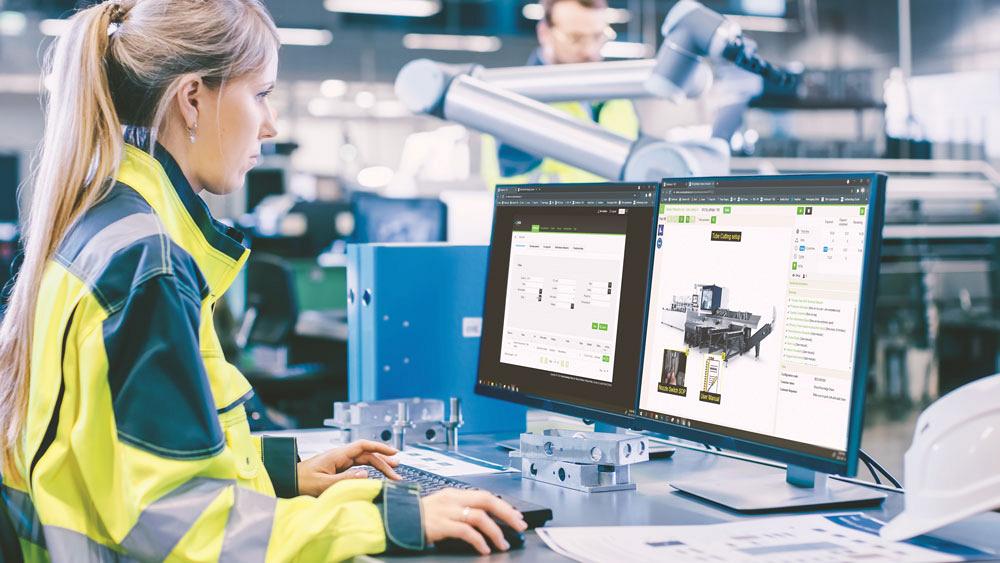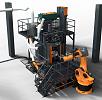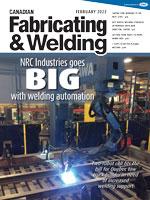- FMA
- The Fabricator
- FABTECH
- Canadian Metalworking
The ins and outs of assembly management
Make the assembly process more efficient with different methods and tools
- February 23, 2023
- Article
- Automation and Software

On any shop floor, there are multiple ways to complete a job. However, without an intelligent solution aiding standardization, it’s hard to apply any consistency and continuous improvements.
Assembly is a key part of the industrial process. From joining parts with nuts and bolts to welding materials together, and even fabricating raw materials to supply the process, intelligent assembly management is a much-needed practice across the industry.
But assembly management will look quite different depending on the company. High-volume, low-mix manufacturers with a linear production line will experience different challenges than low-volume, high-mix manufacturers with production lines and workcells that experience irregular frequencies and different products.
However, while assembly management will vary depending on the size and structure of the company, there are still key methodologies and technologies that can make assembly management processes more effective.
Types of Production Environments
Bottlenecks can happen anywhere, and it’s important to find ways to ensure that parts can get from design to shipping with few to no issues. So, what production methods and technologies can help prevent bottlenecks?
First, it’s important to assess your existing workflow. Manufacturing assembly companies generally fall into two broad categories:
- Low-mix, high-volume (LMHV)
- High-mix, low-volume (HMLV)
LMHV manufacturing, performed by companies like General Motors, has a relatively linear production process. Each car is built using the same highly repeatable process within a fairly straightforward production line. The sheer number and frequency of products being built makes this assembly scheme possible. LMHV manufacturers invest a lot of time and money in automated infrastructure that strengthens and standardizes their linear processes.
HMLV manufacturing is somewhat the opposite. Instead of building one product in a massive assembly line, these companies build everything from medical devices and toys to mechanical shelves and X-ray scanners in multiple assembly lines and workcells. Depending on current contracts and production orders, each month or week can look different from the last, meaning these manufacturers need intelligent methods to enact effective assembly management across multiple, ever-changing operations.
Both LMHV and HMLV companies also can be vertically integrated with fabrication, welding, machining, assembly, and more carried out within the same facility, which introduces a greater need for standardization and process control.
Production Methodologies
LMHV and HMLV manufacturers use various strategies to ensure that their assembly management procedures and practices are on point. And certain methodologies are more beneficial to each environment.
Lean Manufacturing & JIT. Lean Manufacturing and just-in-time (JIT) are well-known production methodologies originally developed by Toyota.

For companies involved in low-volume, high-mix environments, strict lean methodologies won’t precisely fit their complex and ever-changing structures.
The goal of lean manufacturing is to mitigate waste and add value to the customer. By taking an in-depth look at production flow with a lean concept in mind, manufacturers identify which production factors are not contributing to the value of the product and which actions are actively causing unnecessary waste.
JIT, on the other hand, continues this emphasis on waste mitigation by prompting businesses to create a product just-in-time for delivery. The basic principle is that if a product is produced ahead of time, then there is wasted surplus time that should’ve been used to make the product better.
Theory Of Constraints. According to the theory of constraints, it is almost impossible to distribute work evenly because of various constraints and bottlenecks within all operations. Once a constraint has been identified, manufacturers need to take two key actions:
- Always keep the constraint working at 100%.
- Mitigate large buildups of products before the constraint.
The theory of constraints within an HMLV environment can be analogized with cooking steak and potatoes at a restaurant. The steak and potatoes have varying preparation and cooking times. Plus, customers want each item warm, meaning chefs can’t prepare the plate in advance. Adding to this, some customers want their steak medium well while others want mashed potatoes instead of fries, introducing more complexity to the plate assembly process. Similarly, within HMLV environments, varying parts need to reach assembly simultaneously.
Imagine that a battery takes three hours to complete, while the battery harness only takes 30 minutes. If you want to mitigate waiting, you could begin fabricating the battery harness 2 hours and 30 minutes after the battery work order has begun, ideally enabling both components to convene at the assembly stage at the same time.
But assembly management is not always so simple. With no time to spare, the above process does not allow for any fluctuations in the assembly line. To solve this issue, manufacturers can deploy a drum-buffer-rope system to maintain flow and exploit constraints fully:
- Drum: a constraint that sets the pace/rhythm of production
- Buffer: the amount of time added prior to the drum
- Rope: the scheduled release of the work order
The buffer is created by carefully planning when work orders are released (rope). Adding a buffer before drums ensures that the drum never slows down or sits inactive. If ever there's an issue in the production line before the drum, you still have a couple of hours’ or days’ worth of work that maintains the maximum output of the constraint.
Who Should Use These Methodologies?
In some ways, the Theory of Constraints will contradict many of the tenets of lean manufacturing and JIT.
Typically, the goals of lean and JIT are to get parts in and out quickly, eliminate any waste, and find a consistent and predictable flow. These methodologies align closely with linear production environments, where everything moves in a repetitive and often automated production line, making lean and JIT great for assembly management within an HVLM environment.
But even LMHV manufacturers can experience bottlenecks, making the Theory of Constraints a useful tool to schedule machine maintenance and downtime intelligently.

Thanks to the advancements of Industry 4.0, more tools than ever are available that help manufacturers enact the best solutions for their business.
Strict lean methodologies won’t precisely fit the complex, ever-changing structures of LVHM manufacturers. And while lean concepts can still be introduced to mitigate waste and increase value in HMLV manufacturing, these companies often don’t have the real estate or long-term contracts to achieve the type of optimization that Ford, Toyota, or Coca-Cola regularly experience.
Additionally, since HMLV companies typically depend on manual labor for each process, the risk of human error is much greater. For this reason, HMLV companies often need to enact more manual control over their assembly management process by identifying bottlenecks, introducing buffers, intelligently scheduling work orders, and optimizing their workforces for the constantly changing work.
It's crucial to remember that there’s no one-size-fits-all approach. Every manufacturer needs to understand and identify their shop floor realities before deciding which methodology and technologies make sense for them.
Which Technologies Should You Use?
Enacting an effective assembly management strategy relies on more than an understanding of these methodologies. Specific technologies will greatly benefit the operation as well.
When looking at various solutions, it’s crucial to ensure that your chosen software will scale with your goals and long-term plans. Think about addressing current pain points and how you’ll address future concerns as your digital transformation evolves over time.
It is also important to look for systems that emphasize and enhance the abilities of the workforce. Since they are the ones performing and managing the value-added work, any tool that empowers them also empowers the whole operation.
Key features that strengthen workers on the shop floor are:
- Easy-to-use work instructions that standardize the process.
- Quick training methods that facilitate new skills and cross-training.
- Intelligent communication, feedback, and engagement with workers.
- Insightful employee and process monitoring.
- Easy integration with other software and smart tools.
On any shop floor, there are multiple ways to complete a job. However, without an intelligent solution aiding standardization, it’s hard to apply any consistency and continuous improvements. Manufacturers can opt for a general manufacturing enterprise system to help drive operations, but this type of tool is not an expert at any one thing.
Thanks to the advancements of Industry 4.0, more tools than ever are available that help manufacturers enact the best solutions for their business.
Work instruction software provides operators with the necessary digital tools to flow intuitively through their varying processes with a repeatable and highly accurate format. Through the use of pictures, videos, and annotations, workers can complete any job because they have access to the right knowledge and skills at their fingertips.

Work instruction software provides operators with the necessary digital tools to flow intuitively through their varying processes with a repeatable and highly accurate format.
Plus, unlike paper, this digital system enables manufacturers to update their instructions easily, meaning no more searching for loose papers or worrying that someone is following an old version of the process.
Smart technology is making systems even more intuitive through IoT connections with smart tools. As operators follow their instructions, the software sends a signal to the assembly tool, letting it know how much force should be applied to each fastener. As workers insert and tighten each bolt, nut, or screw, the software automatically moves the work instruction to the next step and validates and records the torque value that was achieved. The software also locks the tool from use when it is not needed. This innovation eliminates the possibility of tool errors and keeps the operator in sync with the standardized process.
Additionally, shop floor operators can communicate feedback directly through the software. An operator who notices a problem or sees an area for improvement can immediately place a note or send a message to the supervisor. This process enables companies to enact powerful continuous improvement within their assembly management strategies and technologies.
Similarly, leaders can closely monitor performance and process health by gathering production and quality data in real time. The information can be captured autonomously by the software or manually by the operator through smart forms embedded in the work instructions.
Daily management systems are useful tools as well, enabling team leaders to perform daily audits during which they can log discrepancies, flag issues, and enact solutions. Companies can use work instruction software to create detailed process audits and gemba walks. Once the audit is completed, the information is automatically stored for tracking performance.
Expand the Capabilities of Assembly Management Tools
Having an accurate, up-to-date process for workers to follow that provides all the relevant information can be a challenge, but this is where many of today’s software options shine.
While individual software tools are great for solving specific issues, modern enterprise solutions enable users to connect to other systems to create a strong digital thread throughout their operation. Manufacturers can integrate live bills of materials and tool lists into every work instruction through integration with an enterprise resource planning system. And by connecting the software to a business intelligence solution, they centralize all data to form a connected factory with a live, digital twin.
When optimizing your assembly management process, look for tools that can identify and correct issues quickly to ensure accuracy and quality while empowering the operator with accurate knowledge and skills.
Ryan Zimmermann is director of business development, Spero Zervos is customer success manager, and Ben Baldwin is content marketing specialist for Visual Knowledge Share (VKS), 1241 Rue Des Cascades, Châteauguay, Que. J6J 4Z2, vksapp.com.
subscribe now


Keep up to date with the latest news, events, and technology for all things metal from our pair of monthly magazines written specifically for Canadian manufacturers!
Start Your Free Subscription- Trending Articles
FMA Annual Meeting: Ingenuity still key with tech innovations

Messer Canada hosts anniversary event

Welding jacket designed for protection, comfort

Gang punching press system accommodates different parts quickly

Compact swing chamber shot blast machine features robotic workpiece handling

- Industry Events
MME Saskatoon
- May 28, 2024
- Saskatoon, SK Canada
CME's Health & Safety Symposium for Manufacturers
- May 29, 2024
- Mississauga, ON Canada
DiPaolo Machine Tools Open House 2024
- June 4 - 5, 2024
- Mississauga, ON Canada
FABTECH Canada
- June 11 - 13, 2024
- Toronto, ON Canada
Zoller Open House & Technology Days 2024
- June 12 - 13, 2024
- Ann Arbor, MI















